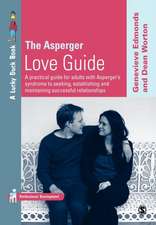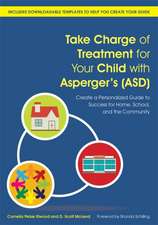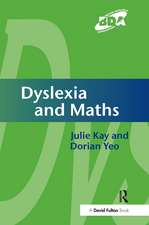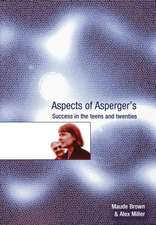Emotional and Behavioral Problems: A Handbook for Understanding and Handling Students
Autor Paul Zionts, Laura T. Zionts, Richard L. Simpsonen Limba Engleză Paperback – 6 mai 2002
Emotional and Behavioral Problems is designed to be a resource for persons dealing with children and adolescents who have emotional and/or behavioural disabilities.
This book is invaluable to professionals dealing with children in all situations as well as to families.The information provided about childhood and adolescent emotional and behavioural problems is both straightforward and basic.
| Toate formatele și edițiile | Preț | Express |
|---|---|---|
| Paperback (1) | 322.81 lei 43-57 zile | |
| SAGE Publications – 6 mai 2002 | 322.81 lei 43-57 zile | |
| Hardback (1) | 511.89 lei 43-57 zile | |
| SAGE Publications – 29 iul 2002 | 511.89 lei 43-57 zile |
Preț: 322.81 lei
Nou
Puncte Express: 484
Preț estimativ în valută:
61.77€ • 64.67$ • 51.11£
61.77€ • 64.67$ • 51.11£
Carte tipărită la comandă
Livrare economică 07-21 aprilie
Preluare comenzi: 021 569.72.76
Specificații
ISBN-13: 9780761977049
ISBN-10: 076197704X
Pagini: 256
Dimensiuni: 178 x 254 x 13 mm
Greutate: 0.45 kg
Ediția:First Edition
Editura: SAGE Publications
Colecția Corwin
Locul publicării:Thousand Oaks, United States
ISBN-10: 076197704X
Pagini: 256
Dimensiuni: 178 x 254 x 13 mm
Greutate: 0.45 kg
Ediția:First Edition
Editura: SAGE Publications
Colecția Corwin
Locul publicării:Thousand Oaks, United States
Recenzii
"This book is an excellent overview of a very complex area. It is a useful guide to identifying and treating children with emotional and behavioral disabilities (EBD), and is particularly outstanding on topics related to the educational system and the numerous laws and policies surrounding the education of EBD children. This book will serve the field well."
"This serves as a great resource for educators who want to know more about youth with emotional and behavioral disorders and the needs of their families. I know I will draw from it in the future to orient new staff working with emotionally and behaviorally challenged youth."
"This serves as a great resource for educators who want to know more about youth with emotional and behavioral disorders and the needs of their families. I know I will draw from it in the future to orient new staff working with emotionally and behaviorally challenged youth."
Cuprins
Preface
Acknowledgments
About the Authors
Part One: Understanding Emotional and Behavioral Disorders
1: Introduction to Emotional Disturbance and Behavioral Disorders
By Any Other Name: Emotional and Behavioral Disorders
Possible Causes of Emotional Disturbance and Behavioral Disorders
Incidence
Serious Emotional Disturbance or Behavioral Disorders or EBD: What's the Difference?
How Professionals View Labels
Identification of EBD
Behaviors That Fit Into Educational Stages
Characteristics of Emotionally Disturbed or Behaviorally Disordered Children and Youth
Summary
2. Major Types of Emotional and Behavioral Disorders
Externalizing Behaviors
Internalizing Behaviors
Function Disorders
Summary
3. Causes of Emotional and Behavioral Disorders
Understanding Factors Related to the Development of EBD
Understanding Potential Causes of EBD
Summary
4. Evaluating and Assessing Students Who Have Emotional and Behavioral Disorders - Laura Zionts & Katherine deGeorge
The Purpose of Evaluation
An Overview of EBD Evaluation
Specific Aspects of the Evaluation Process as They Relate to EBD
Evaluation Techniques Used to Determine Eligibility
Summary
5. Violence and Aggression in Schools - Sara Sibilsky, Paul Zionts
Violence and Aggression in the Schools
The Roots of Violent and Aggressive Behaviors in Children and Adolescents
Violence, Aggression, and EBD
Responses to School Violence and Aggression
Reducing and Preventing Violence and Aggression
Summary
6. Adolescents Who Have Emotional and Behavioral Disorders and the Juvenile Justice System
Background Information on EBD and the Juvenile Justice System
Perplexing Issues of Ethnicity, Mental Health, and Juvenile Justice in the United States
Addressing Issues of Ethnicity and Bias in Juvenile Justice Agencies
Addressing the Mental Health Needs of All Youth in the Juvenile Justice System
Special Education and the Juvenile Justice System
Juvenile Justice and Youth Who Have EBD: Intervention and Reintegration Strategies
Summary
Part Two: Helping Students Who Have Emotional and Behavioral Disorders
7. Treatment of Emotional and Behavioral Disorders
Behavior Modification
Examples of Two Behavior Modification Programs
Schoolwide Discipline: Positive Behavioral Supports
Cognitive Behavior Therapy
Summary
8. School-Based Placements
After Identification
Determining Appropriate Educational Goals
The Least Restrictive Environment
The Continuum of Services: Placement Options
An Important Caveat About Placements
Possible Parental Reactions to Placement Options
Changing Placements Because of Behavior
A Few Words About Inclusion
Summary
9. Supporting Students With Emotional and Behavioral Disorders Outside the Public School Setting
Medications for Emotional and Behavioral Disorders: Psychopharmacology
The Role of Psychiatric and Juvenile Justice Professionals on the IEP Team
Collaborative Efforts Between Mental Health Agencies and the Educational System
Systems of Care
Insurance, Managed Care, Medicare, and Systems of Care
Summary
10. The Role of Families in Supporting Children With Emotional and Behavioral Concerns - Karen Anhalt, Richard Simpson, Laura Zionts
Parents as Referral Agents
Teachers as Referral Agents
Parents as Advocates for Their Children With Emotional and Behavioral Concerns
The Importance of Being a Support Agent
Implementing Changes at Home
Exercises for Improving Communication
Ideas to Improve Discipline Strategies at Home
Finding Ways to Relieve Stress
Summary
11. What Lies Ahead: Postschool Transition
Critical Concepts About EBD
Postschool Success
Transition Planning
Summary
Resources for Professionals and Parents - Laura Zionts, Katherine deGeorge
Index
Acknowledgments
About the Authors
Part One: Understanding Emotional and Behavioral Disorders
1: Introduction to Emotional Disturbance and Behavioral Disorders
By Any Other Name: Emotional and Behavioral Disorders
Possible Causes of Emotional Disturbance and Behavioral Disorders
Incidence
Serious Emotional Disturbance or Behavioral Disorders or EBD: What's the Difference?
How Professionals View Labels
Identification of EBD
Behaviors That Fit Into Educational Stages
Characteristics of Emotionally Disturbed or Behaviorally Disordered Children and Youth
Summary
2. Major Types of Emotional and Behavioral Disorders
Externalizing Behaviors
Internalizing Behaviors
Function Disorders
Summary
3. Causes of Emotional and Behavioral Disorders
Understanding Factors Related to the Development of EBD
Understanding Potential Causes of EBD
Summary
4. Evaluating and Assessing Students Who Have Emotional and Behavioral Disorders - Laura Zionts & Katherine deGeorge
The Purpose of Evaluation
An Overview of EBD Evaluation
Specific Aspects of the Evaluation Process as They Relate to EBD
Evaluation Techniques Used to Determine Eligibility
Summary
5. Violence and Aggression in Schools - Sara Sibilsky, Paul Zionts
Violence and Aggression in the Schools
The Roots of Violent and Aggressive Behaviors in Children and Adolescents
Violence, Aggression, and EBD
Responses to School Violence and Aggression
Reducing and Preventing Violence and Aggression
Summary
6. Adolescents Who Have Emotional and Behavioral Disorders and the Juvenile Justice System
Background Information on EBD and the Juvenile Justice System
Perplexing Issues of Ethnicity, Mental Health, and Juvenile Justice in the United States
Addressing Issues of Ethnicity and Bias in Juvenile Justice Agencies
Addressing the Mental Health Needs of All Youth in the Juvenile Justice System
Special Education and the Juvenile Justice System
Juvenile Justice and Youth Who Have EBD: Intervention and Reintegration Strategies
Summary
Part Two: Helping Students Who Have Emotional and Behavioral Disorders
7. Treatment of Emotional and Behavioral Disorders
Behavior Modification
Examples of Two Behavior Modification Programs
Schoolwide Discipline: Positive Behavioral Supports
Cognitive Behavior Therapy
Summary
8. School-Based Placements
After Identification
Determining Appropriate Educational Goals
The Least Restrictive Environment
The Continuum of Services: Placement Options
An Important Caveat About Placements
Possible Parental Reactions to Placement Options
Changing Placements Because of Behavior
A Few Words About Inclusion
Summary
9. Supporting Students With Emotional and Behavioral Disorders Outside the Public School Setting
Medications for Emotional and Behavioral Disorders: Psychopharmacology
The Role of Psychiatric and Juvenile Justice Professionals on the IEP Team
Collaborative Efforts Between Mental Health Agencies and the Educational System
Systems of Care
Insurance, Managed Care, Medicare, and Systems of Care
Summary
10. The Role of Families in Supporting Children With Emotional and Behavioral Concerns - Karen Anhalt, Richard Simpson, Laura Zionts
Parents as Referral Agents
Teachers as Referral Agents
Parents as Advocates for Their Children With Emotional and Behavioral Concerns
The Importance of Being a Support Agent
Implementing Changes at Home
Exercises for Improving Communication
Ideas to Improve Discipline Strategies at Home
Finding Ways to Relieve Stress
Summary
11. What Lies Ahead: Postschool Transition
Critical Concepts About EBD
Postschool Success
Transition Planning
Summary
Resources for Professionals and Parents - Laura Zionts, Katherine deGeorge
Index
Notă biografică
Paul Zionts is a professor of special education and Chairperson of the Department of Educational Foundations and Special Services at Kent State University. He has been a teacher in a reform school and an inner-city high school, a program director, consultant, and teacher trainer. He has lectured and provided training in local, state, and national events and has conducted hundreds of workshops that have included teachers, counselors, psycho logists, social workers, administrators, parents, secretaries, and bus drivers. He has authored Teaching Disturbed and Disturbing Students (2nd edition) and Inclusion Strategies for Students with Learning and Behavior Problems, and he has coauthored with Richard Simpson both Autism (2nd edition) and Understanding Children and Youth with Emotional and Behavioral Problems.
Descriere
The authors take a complex, under-discussed topic and give teachers and administrators useful, basic guidelines they can put to use quickly in understanding, identifying, and helping this special group of students.













